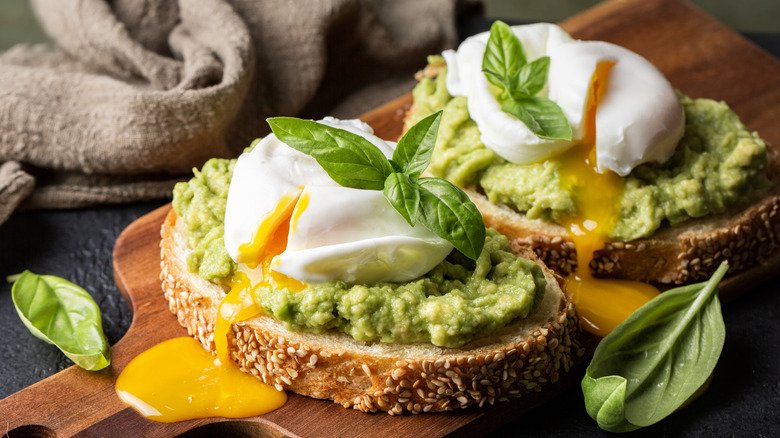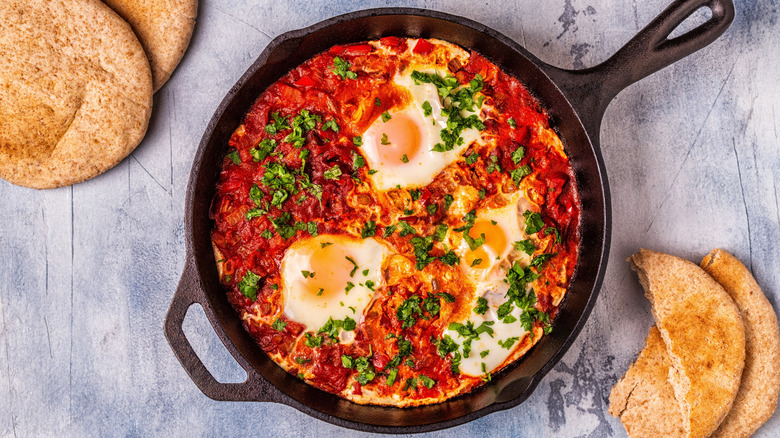How To Poach Eggs Perfectly Every Time Using Your Air Fryer
For a product launched not too long ago (circa. 2010,) the air fryer has taken the world by storm. A vessel of efficiency, this multi-purpose appliance eliminated the need for a microwave to reheat food, a deep fryer to achieve crispy perfection, and an oven to quickly roast or bake with ease. One lesser used function is its ability to gently poach eggs. That's right, if you've got an air fryer you can skip the long process of getting out the pot, boiling your water, and hoping that you've got the timings right.
To make air fryer poached eggs, all you need is a ramekin, a small, heatproof dish typically used for souffles. These are a bit niche, so if you don't have one, just grab a dish deep enough to submerge the egg such as an oven-safe bowl or mug. While your air fryer is preheating, partially fill your bowls with hot water and crack your eggs into them. There should only be one egg per bowl. Place your bowls into the air fryer and cook for around 6 to 10 minutes, depending on your desired doneness. If you're a poached eggs pro, you'll have noticed that the air fryer version takes significantly longer than the boiling method, which takes closer to three minutes on average. This is due to the different cooking methods: boiling provides a steady, even heat; air fryers circulate hot air, which is a less direct mode of heat transfer.
Once the eggs are done, carefully remove the bowl from the air fryer (it will be hot!) Take the eggs out using a slotted spoon and enjoy!
Ways to upgrade your air fryer poached eggs
When poaching eggs using the traditional method, there are several pro-tricks you can use to elevate them to the next level, which can also be applied to your air fryer poached eggs. A tip for smoother poached eggs is removing the thin, watery portion of the egg whites before poaching. This step helps prevent those unappetizing, straggly bits that often collect in the pot. To remove, strain your egg over a fine-mesh strainer, allowing the discarded water bits to collect in a bowl underneath. Another handy trick is adding white vinegar into your poaching liquid. Vinegar is a poaching essential because its acidity causes the egg whites to set faster, encouraging them to hold their shape and preventing any rogue strands from forming. Since the air fryer bowl will be much smaller than a boiling pot, we recommend only adding a small dash of vinegar, otherwise your eggs might pick up an overwhelming tart, acidic flavor.
Beyond presentation, you can also enhance the flavor and overall character of your air fryer eggs by rethinking the poaching liquid. Instead of water, you could try using a homemade vegetable stock for a rich, savory depth; rich tomato sauce for a shakshuka-style eggs; or even a blend of milk and cream for an ultra-silky, creamy finish. To layer in even more character, infuse your liquid of choice with aromatics. Fresh herbs like rosemary or thyme will brighten the flavor, while garlic or shallots will add a gentle, savory complexity to your poached eggs.
How to enjoy your airfryer poached eggs
Among the many ways to cook them, poached eggs are a breakfast and brunch favorite, perhaps only rivalled by scrambled in popularity. Few things are quite as satisfying as a runny yolk surrounded by tender whites, finished with a sprinkle of cracked black pepper and sea salt. For breakfast and brunch, you should draw your inspiration from the tried-and-tested classics. Think eggs Benedict, a toasted English muffin layered with bacon, a poached egg, and a drizzle of creamy Hollandaise sauce. If you're going for something simpler, yet equally as elegant, you can pair your poached egg with smoked salmon on toast, topped with a garnish of fresh dill. Of course, no homemade avocado toast is complete without being topped by a poached egg, salt, pepper, and even ricotta for extra creaminess.
Beyond breakfast and brunch, poached eggs can still hold their own in heavier dishes. For example, they're the perfect toppings for ramen or udon noodles. In Japan, slow-poached eggs cooked at lower temperatures is known as onsen tamago, which translates to hot spring eggs, reflecting their traditional cooking style of being cooked inside hot springs. By adjusting the temperature, cooking time, and not cracking the eggs, you can mimic the cooking process of an authentic onsen tamago. Paired with tender noodles, a savory broth, scallions, and a sprinkling of nori, onsen eggs will make a great addition to any bowl of ramen, with the custardy yolk adding a smooth, creaminess to the broth.



